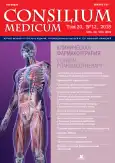Modern aspects of ischemic stroke prevention in internal medicine specialists practice
- Authors: Shishkova V.N1
-
Affiliations:
- Center for Speech Pathology and Neurorehabilitation of the Department of Health of Moscow
- Issue: Vol 20, No 12 (2018)
- Pages: 80-85
- Section: Articles
- URL: https://journals.rcsi.science/2075-1753/article/view/95138
- DOI: https://doi.org/10.26442/20751753.2018.12.180158
- ID: 95138
Cite item
Full Text
Abstract
Keywords
Full Text
##article.viewOnOriginalSite##About the authors
V. N Shishkova
Center for Speech Pathology and Neurorehabilitation of the Department of Health of Moscow
Email: veronika-1306@mail.ru
канд. мед. наук, ст. науч. сотр. 109240, Russian Federation, Moscow, ul. Nikoloyamskaia, d. 20
References
- Инсульт. Руководство для врачей. Под ред. С.В.Котова, Л.В.Стаховской. М.: Издательство МИА, 2013.
- O’Donnell M, Xavier D, Liu L et al. INTERSTROKE Investigators. Risk factors for ischemic and intracerebral hemorrhagic stroke in 22 countries (the INTERSTROKE study): a case-control study. Lancet 2010; 376: 112-23.
- Christiansen C, Gerds T, Olesen J et al. Atrial fibrillation and risk of stroke: a nationwide cohort study. Europace 2016; 18: 1689-97.
- Авдонина М.А., Наседкина Т.В., Иконникова А.Ю. и др. Исследование ассоциации полиморфных маркеров генов F12, PON1, PON2, NOS2, PDE4D, HIFla, GPIba, CYP11B2 с ишемическим инсультом среди русского населения Центральной России. Журн. неврологии и психиатрии им. С.С.Корсакова. 2012; 112 (2): 51-4.
- Шишкова В.Н., Ременник А.Ю., Валяева В.Н. и др. Изучение ассоциаций полиморфных вариантов генов липидного и углеводного обменов, сосудистого воспаления и нейротрансмиттерных систем с развитием первого ишемического инсульта. Кардиоваск. терапия и профилактика. 2017; 16 (5): 27-33.
- Шишкова В.Н., Адашева Т.В, Ременник А.Ю. и др. Прогностическая значимость клинико-антропометрических, биохимических, метаболических, сосудисто-воспалительных и молекулярно-генетических маркеров в развитии первого ишемического инсульта. Журн. неврологии и психиатрии им. С.С.Корсакова. 2018; 2: 4-11.
- Шишкова В.Н., Адашева Т.В., Ременник А.Ю. и др. Предикторы развития повторного ишемического инсульта. Врач. 2018; 29 (2): 38-44. doi: 10.29296/25877305-2018-02-10
- Фонякин А.В., Гераскина Л.А. Профилактика ишемического инсульта. Рекомендации по антитромботической терапии. Под ред. З.А.Суслиной. М.: ИМА-Пресс, 2014.
- Furie K, Kasner S, Adams R et al. Guidelines for prevention of stroke in patients with ischemic stroke or transient ischemic attack. AHA/ASA Guideline. Stroke 2011; 42: 227-76.
- Goldstein L, Bushnell Ch, Adams R et al. Guidelines for the Primary Prevention of Stroke: A Guideline for Healthcare Professionals From the American Heart Association/American Stroke Association. Stroke 2011; 42: 517-84.
- Guidelines for Management of Ischaemic Stroke and Transient Ischaemic Attack. The European Stroke Organization (ESO), 2008. http://www.eso-stroke.org
- Jauch E, Saver J, Adams H et al. Guidelines for the Early Management of Patients With Acute Ischemic Stroke. Stroke 2013; 44: 870-947.
- Kernan W et al. Guidelines for the prevention of stroke in patients with stroke and transient ischemic attack: a guideline for healthcare professionals from the American Heart Association/American Stroke Association. Stroke 2014; 45: 2160-236.
- Intercollegiate Stroke Working Party. National clinical guideline for stroke, 4th ed. London: Royal College of Physicians, 2012.
- Rashid P, Leonardi-Bee J, Bath P. Blood pressure reduction and secondary prevention of stroke and other vascular events: a systematic review. Stroke 2003; 34 (11): 2741-8.
- Клинические рекомендации «Диагностика и лечение артериальной гипертензии» Российского медицинского общества по артериальной гипертонии, 2013.
- Рекомендации ЕОК/ЕОА по диагностике и лечению дислипидемий 2016. Рос. кардиол. журн. 2017; 5 (145): 7-77.
- International Diabetes Federation, Diabetes Atlas, 5th ed. International Diabetes Federation, 2011.
- Алгоритмы специализированной медицинской помощи больным сахарным диабетом. Под ред. И.И.Дедова, М.В.Шестаковой, А.Ю.Майорова. 8-й вып. Сахарный диабет. 2017; 20 (1S): 1-112.
- Stamler J, Vaccaro O, Neaton J et al. Diabetes, other risk factors, and 12-yr cardiovascular mortality for men screened in the Multiple Risk Factor Intervention Trial. Diabetes Care 1993; 16 (2): 434-44.
- Шишкова В.Н. Взаимосвязь развития метаболических и когнитивных нарушений у пациентов с сахарным диабетом, предиабетом и метаболическим синдромом. Неврология и Ревматология (Прил. к журн. Consilium Medicum). 2010; 1: 36-43.
- Caswell M, Frank J, Viggiani M.T et al. Accuracy and User Performance Evaluation of a Blood Glucose Monitoring System. Diabetes Technol Ther 2015; 17 (3).
- Stroke Risk in Atrial Fibrillation Working Group. Independent predictors of stroke in atrial fibrillation: a systematic review. Neurology 2007; 69 (6): 546-54.
- Camm A, Lip G, de Caterina R et al. 2012 focused up date of the ESC Guidelines for the management of atrial fibrillation: an update of the 2010 ESC Guidelines for the management of atrial fibrillation. Eur Heart J 2012; 33: 2719-47.
- Диагностика и лечение фибрилляций предсердий. Рекомендации РКО, ВНОА и АССХ, 2017.
Supplementary files






